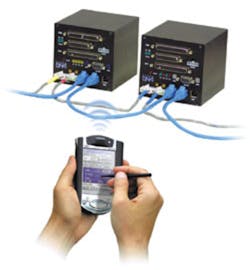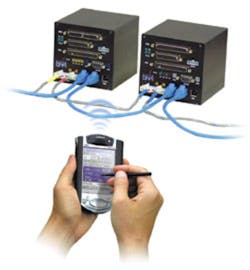A number of factors are driving the development of ever more powerful and flexible data acquisition products. Among them are higher performance semiconductors, widespread adoption of new form factors, the emergence of Ethernet as a viable industrial networking scheme, and the growing use of real-time operating systems. The products you’ll be working with in several years could look quite different than those in use today.
Speed, Resolution Continue to Ramp Up
To get an idea of where data acquisition products are headed with regard to speed and resolution, take a look at the analog-to-digital converters (ADCs) upon which they are built. Not so long ago, boards sampling in the megahertz range were a specialty item.
Now consider the LTC 1743 from Linear Technologies. It digitizes one 12-b channel at 50 MS/s and costs $10.80 in small quantities. At 14 bits, Analog Devices’ AD9245 samples at 80 MHz and sells for $38 in quantities of a thousand. Clearly, you can expect next-generation high-end boards to push out the speed envelope and remain attractively priced.
Meanwhile, 16-b boards are becoming the base standard for most applications because this level of resolution has become so affordable. Soon you might look for products that use chips such as Analog Devices’ AD7655, a four-channel, 16-b successive-approximation ADC that specs 1 MS/s yet sells for $8 per thousand—not much of a strain on the manufacturers’ bill of materials.
Whether they actually need this resolution or not, users are drifting toward products with higher resolution. Confirming this trend is a new study from Venture Development Corp. (VDC) entitled Data Acquisition Product Requirement and Usage Trends.
VDC Group Manager Jim Taylor reported that 16-b boards currently have the largest market share and that should remain the most popular resolution for several years. However, he expects that in 2007 roughly 20% of all data acquisition purchasers will see their maximum resolution requirement jump to 20 bits or higher.
Predictions for the use of higher speeds are somewhat more modest. As Table 1 (see below) shows, Mr. Taylor foresees that in 2007 roughly two-thirds of all board users will work at digitization rates of 10 kHz or greater. Based on semiconductor trends, I believe his projections are too modest and that even more users will shift to boards with higher speeds. Just as they will pay a few extra dollars for higher resolution, they’ll pay a few extra dollars for the added speed, even if they don’t need it today.
Table 1. Projected Trends of External Modules vs. Plug-In Boards as a Function of Digitization Rates (Courtesy of Venture Development Corp.)
Rate
External Chassis and Modules
Plug-In Analog I/O Boards
As the cost of circuitry drops, it’s becoming economical to pack more functionality onto one board. As such, it’s possible to manufacture attractively priced boards that perform true simultaneous sampling over multiple channels.
While on the topic of chips, let’s look at the CPUs that are increasingly finding their way onto data acquisition boards. The benefits of an onboard processor are many. Although Intel-class CPUs have become incredibly powerful, we continue to give our PCs more to do. Just running the operating system takes considerable horsepower, not to mention a graphics-intensive user interface.
However, an onboard data acquisition processor can run all instrumentation activities no matter how heavily you load down the host CPU. Better yet, this chip might give a board exceptional capabilities. Consider a multifunction board with analog I/O, digital I/O, and counter/timers. A data acquisition processor can run all these subsystems independently at full speed. That chip also could run a real-time kernel to achieve hard, real-time performance even when under Windows.
Where Boards Are Headed
For years, engineers have sought form factors that give them mechanical advantages in areas such as shock, vibration, or operating-temperature range yet retain the electrical specs and software compatibility of commercial PCs. One of the first was PC/104, but its small size makes it awkward to develop a system with many channels.
In contrast, CompactPCI boards match the functionality you’ve come to expect in a PCI board, and their chassis provide the industrial ruggedness you’ll need. Going a step further is PCI eXtensions for Instrumentation (PXI). It’s basically the CompactPCI spec with a second group of signals that, for instance, allows for the coordination of analog and digital I/O among several boards or for one board to trigger another. PXI also provides an interboard bus for the movement of data without tying up the system bus.
VDC’s Mr. Taylor predicts double-digit average growth in usage for CompactPCI and PXI boards. He also sees only average growth for PCI and PC/104 boards and significant declines in usage of ISA and VME boards.
Additional market numbers come from Shekar Gopalan, vice president of research and consulting for the Industrial Business Unit of Frost & Sullivan. That firm has a study of this segment underway, and preliminary results show that, measured in units, the PCI bus accounts for 55% to 65% of all boards shipped; CompactPCI/ PXI is the second largest segment with 8% to 12% of the total. The remaining shipments are shared among other formats including PC104, STD, PCMCIA/PCCard, and ISA.
If the number of suppliers that support PXI is any indication, then the bus is well on its way to becoming a popular standard. Fred Bode, president of Bode Enterprises and publisher of the PXI & VXIbus Newsletter, notes that the number of PXI-compliant products grew by 55% during 2002 to reach 883 models.
He also quotes numbers from Prime Data on PXI revenues for shipped products. That market-research firm believes that shipments grew from $70.6 million in 2001 to $95 million in 2002. Achieving growth of 35% in the current economic environment is a significant achievement.
Distributed Even Goes Wireless
Issues of how to best make a board work within a PC-compatible system go away with external data acquisition modules, which communicate with PCs in a variety of ways. Although the serial port remains today’s most popular networking scheme, VDC says that in four years the king will be USB, followed by 100-Mb/s Ethernet, 1-Gb/s Ethernet, and then RS-232 and RS-485 links. It seems our old friend the IEEE 488 bus is riding into the sunset.
One disadvantage with USB and FireWire is the somewhat limited cable lengths they support. Meanwhile, users and suppliers alike have come to see Ethernet as one of the most promising technologies for long-range distributed data acquisition.
First, virtually every PC today comes with integrated networking capability. Second, Ethernet cabling is readily available and inexpensive. Further, vendors are finding ways to supercharge Ethernet and remove hurdles to its widespread adoption in industry.
Thanks to such developments, the future is bright for Ethernet. During the last two years, says a report from the ARC Advisory Group, the aggregate market volume for industrial Ethernet devices has grown at an annual rate exceeding 50%, and the worldwide market for industrial Ethernet devices is expected to grow at a compound annual rate of 84% over the next five years. The market was 286,800 nodes in 2002 and is forecast to reach more than 6 million nodes in 2007 (Figure 2, below).
Figure 2. Shipments of Industrial Ethernet Devices (Courtesy of ARC Advisory Group)
Already you can see the beginnings of the ultimate in networking flexibility: wireless data acquisition. Imagine the freedom of no cables from the PC to the peripheral. Instead of struggling with long cables that are bulky, expensive, and prone to noise, engineers can configure systems that digitize directly at the signal source yet position the control PC in a safe, user-friendly setting or in a mobile environment.
Some PCs come with integrated 802.11 capability that soon should be as standard as a serial port. Furthermore, Bluetooth is making inroads, and that technology is attractive for short-haul applications because the cost for adding it to a data acquisition peripheral is in the range of $5 to $10.
And don’t forget the ever-popular IrDA infrared link. For instance, for its PowerDNA I/O Cubes, UEI has developed an applet that runs on PDAs such as the Compaq iPAQ. This applet allows you to stand next to a cube and, without making any physical connections, take readings from sensors and change the unit’s operating parameters.
Before long, you should be able to do the same tasks from anywhere in the world. It’s not difficult to imagine a remote data acquisition module that monitors a system and, if the process exceeds a setpoint, sends a text message or a screen shot of the control panel to your cell phone. Your response, also over a cell phone, will instruct the unit what corrective measures to take.
Software Often Makes the Difference
Despite chip advances, coming up with a unique design for a data acquisition board is very difficult. As a result, software support is becoming a major differentiating factor among suppliers.
When it comes to application development, users tend to swing toward writing their own code with a traditional programming language such as C/C++ or Visual Basic or to a test-development environment. As for a test-development environment, the undisputed leader in the field is National Instruments’ LabVIEW. In fact, the VDC study finds that among board users, LabVIEW is the most popular programming environment, followed by C++ and Visual Basic. This trend is no surprise to data acquisition hardware suppliers, most of which provide LabVIEW drivers.
Meanwhile, Linux has emerged as a popular alternative to Windows, especially among users who have the technical savvy to install the operating system and perform basic system administration. For mission-critical applications, some users believe that no version of Windows is stable enough. They prefer a hard, real-time system proven to provide deterministic response.
Among the choices are QNX and VxWorks, and for such operating systems, a few data acquisition board vendors have written drivers. Another option gaining popularity is Realtime Linux, combining commercial Linux distributions with real-time kernels such as those from FSMLabs or RTAI.
Making Real-Time Easy
Thanks to some new products, users have an alternative to configuring hardware and software components to make a real-time system. For instance, with LabVIEW Real-Time, you create an application in LabVIEW and download it to a real-time target with special hardware that can run the executable under a real-time kernel such as PharLap ETS from Venturcom.
Until recently, users could only go to National Instruments for hardware to run under this environment. Now, UEI provides LabVIEW Real-Time drivers for its PXI boards, offering users a second source.
A similar approach comes from The MathWorks with its xPC Target System. Here you develop an application under SimuLink and send it to another system for execution.
As for the execution vehicle, the scheme offers unusual flexibility. You can choose among any existing PC-compatible format, whether an office PC, PC/104, CompactPCI, or PXI. The only limit is making sure that the xPC Target package includes drivers for the intended I/O hardware. And although The MathWorks lists support for more than two dozen vendors, because of latency issues, you’re well advised to go with a board that has plenty of onboard FIFO memory.
Guarantee Your Future
As you examine products, be sure to keep your future requirements in mind and try to see how next-generation products will meet those needs. To take advantage of these trends, go with a vendor participating in these leading-edge activities.
About the Author
Paul G. Schreier serves as director of international marketing for United Electronic Industries from his office near Zurich, Switzerland. Previously, he was the founding editor of Personal Engineering & Instrumentation News. Mr. Schreier earned B.A. and B.S.E.E. degrees from the University of Notre Dame and a master’s in engineering management from Northeastern University.
United Electronics Industries, 611 Neponset St., Canton, MA 02021, 781-821-2890, www.ueidaq.com
Return to EE Home Page
Published by EE-Evaluation Engineering
All contents © 2003 Nelson Publishing Inc.
No reprint, distribution, or reuse in any medium is permitted
without the express written consent of the publisher.
July 2003


